i joined MoviePass in 2013 and over the next few years watched 6-10 movies [in theaters] per month for just $35 bucks.
MoviePass is like ClassPass for movies, except they didn’t fail and it’s a lot better.
in light of the recent price drop to $9.99 /month, i’m sharing thoughts on why MoviePass has the opportunity to control what films are made, with which talent, and how they’re distributed to consumers.

first, a brief review of the movie business epicenter: the theater.
origin of movie theaters
the first motion picture projected in the US was in 1896 at Koster and Bial’s in New York City.
around 10 years later the Nickelodeon, or “nickel” (5 cent) movie style made its debut, increasing the popularity and accessibility of film.
motion pictures remained silent and dull until the late 1920s, however, when advancements in audio technology gave films life — dialogue.
prior to embedded audio, presentation investments were made to engage movie-goers, in near parallel chronology to increasing film budgets:
- 1900’s – resident pianist, improvising
- 1910’s – specialized pianist, playing loosely synchronized compositions
- 1920’s – pianist + orchestra (seated in the “orchestra pit,” the empty space between front row and stage)
following the introduction of audio in the early 30’s, films became even more complex (see: plot lines) and consumer intellect began to demand more mature forms of storytelling.
crude, slapstick comics such as The Three Stooges became tiresome for theater regulars, who began to prefer dramatic performances by Humphrey Bogart in the likes of Casablanca, released in 1942.
evolution of movie theaters
there are several obvious reasons folks went to the movies – back then as today – but a few less obvious ones, too.
movies were cheap
during the Depression, movies were a reliable and inexpensive(!) form of entertainment, relied upon “to escape the realities of a sluggish economy and scarce employment opportunities.”
Dr. Jim Jones expands:
“The Depression, which began in the fall of 1929, had virtually ended for the film industry by 1935. At that time attendance was back to around 80 million a week, only 10 million short the level attained just prior to the Depression.”
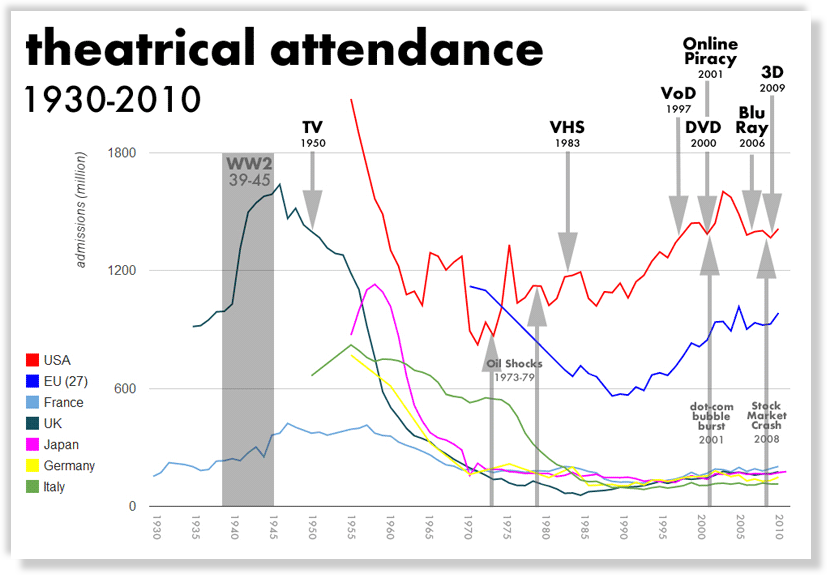
even during the earlier years of the depression, weekly attendance never dipped below 60 million Americans, an incredible number of people given the population of the United States in the early 1930’s was 122 million.
movies were practical
clever promotions also improved during The Depression, to assuage theater-goers who wondered if spending limited resources on movies (vs food) was a good idea.
Dr. Jones continues:
“For forty cents she got an article which would normally cost twenty cents or more at a store and also saw a double feature.” This worked to create regular customers out of women, who came back to the theatre each week until they got every piece and completed the set. This type of promotion would last for months and some even ran as long as 86 weeks.
movies had no substitute
while box office prices increased more than 15x between the early 20th century and the late 1960’s, filmmakers and theaters still enjoyed at least 1-2 elements that the majority of its consumers did not:
- full-color screens
- audio equipment
- air conditioning
VHS tapes didn’t launch for another decade, finally debuting in 1978 in the UK, and cost nearly $3,800 when adjusting for current day inflation.
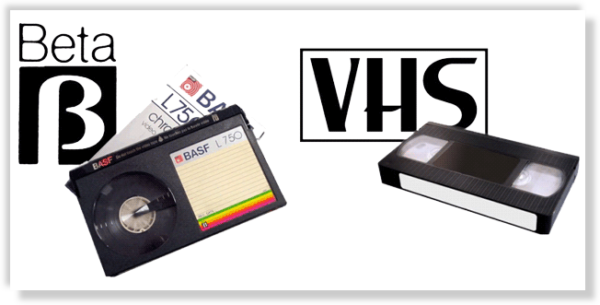
making the at-home alternative even murkier was the VHS <> Betamax “war,” which was finally won by JVC (inventors of VHS) in the early 1980’s.
movie budgets over time
the average cost to produce an MGM film in the 1920’s was $160,000. from a look at IMDB, today it costs around $139 million to make a major Hollywood film.
accounting for inflation, we can see that over 52% of the 63 most expensive movies were produced in the last 7 years:
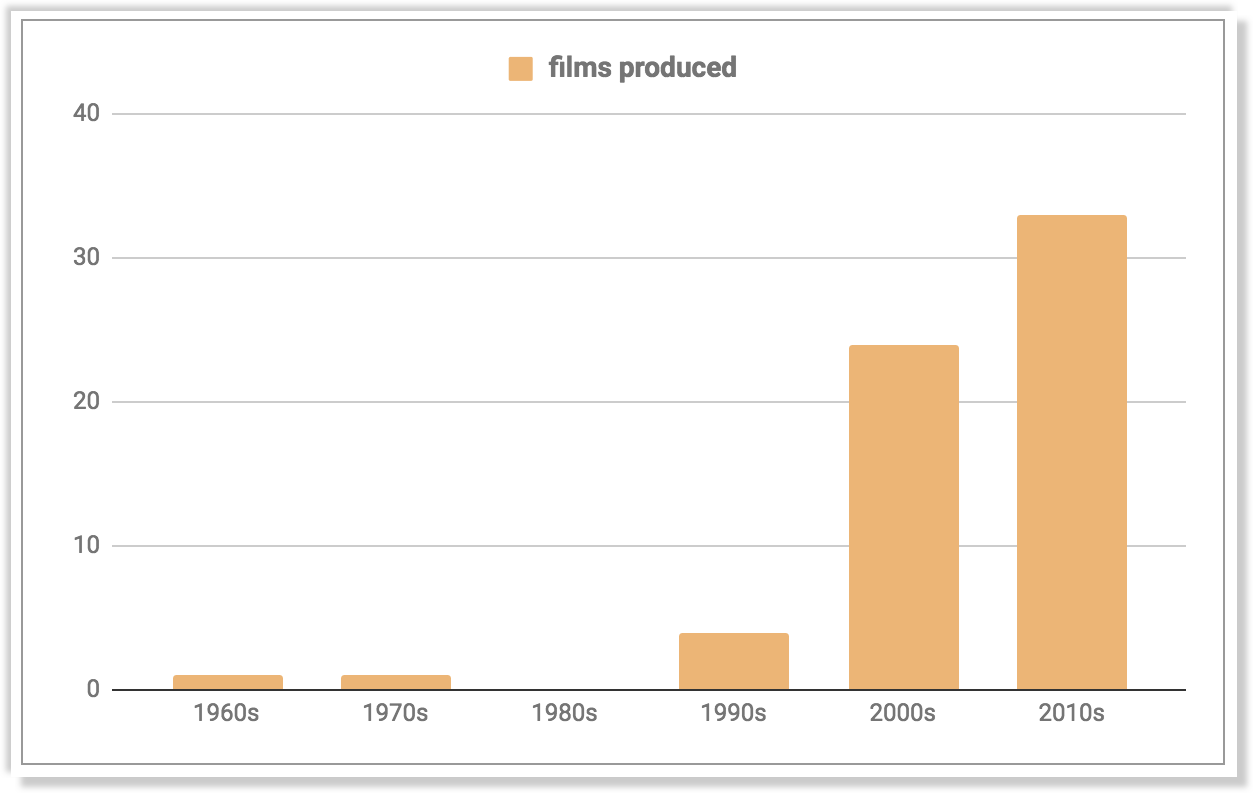
perhaps even more interesting is the incredibly budget-friendly 1960’s.
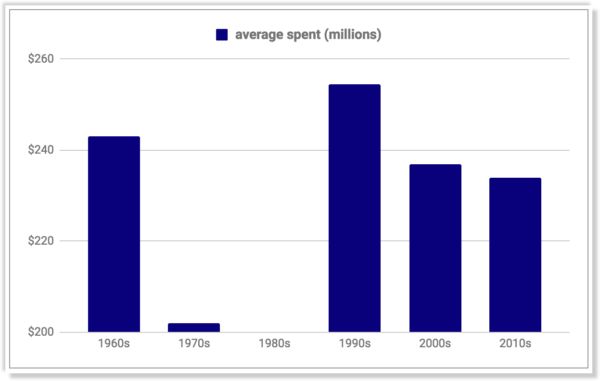
remember: the 60’s were a perfect storm of high production value and few DIY alternatives. this was also the dawn of James Bond and several other long-running action [expensive] series.
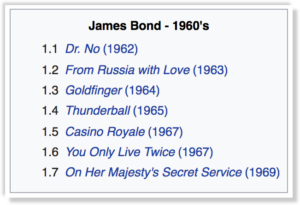
how the box office works
according to Box Office Mojo, the number of major films released per year has grown from 161 (1980s) to more than 730 per year in 2016.
this 453% increase in content is fantastically disproportionate to the mere 33% growth in movie-goer attendance since 1980, as seen in the Theatrical Attendance timeline above.
putting together saturated availability with exponentially increased budgets, and only linear growth in movie theater attendance… what does this mean for the future of the major film industry?
John Campea wrote an interesting piece 10 years ago titled “where our money goes and why [movies] cost so much.”
in sum:
- theaters (distributors) are paid on a % sliding scale
- concessions are expensive because they keep theaters in business
according to John, huge movies like Star Wars command 100%(!) of box office revenues for upwards of 1 week following release.
over time this split increases from 0 – 20%, then 40%, to as high as 80% when the film is old news, aka when your grumpy uncle and his oxygen tank are alone in the theater at 2pm on a Monday.
a typical movie release cycle looks something like this:
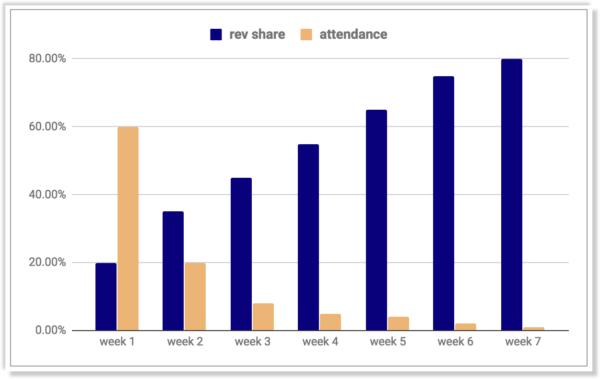
these economics represent a paradigm for distributors, whose costs (staff) are the highest when revenue is lowest.
redefining capitalism in Hollywood
it’s long been understood that owning the means of production is a necessary ingredient for any individual or entity seeking wealth.
thus, Hollywood fronts $139 million for a film, and movie theaters “deal with” whatever scraps they’re given to click “play.”
until now. i sense a major shift in the business:
distributors are becoming the means of production, and Hollywood its mere labor force.
Netflix is a perfect example.
initially a flavorless, jokingly public utility, Netflix has since ripped off its “we show your stuff” mask to reveal Netflix Studios.
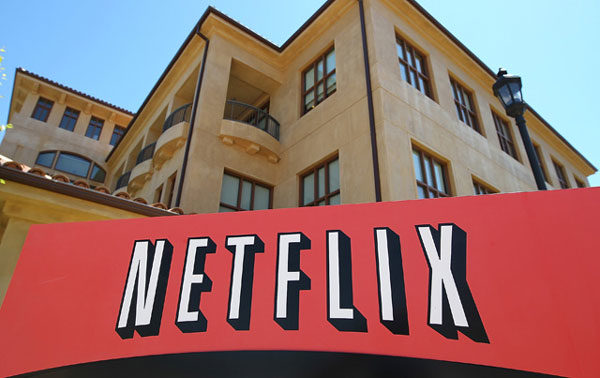
with Amazon and Hulu following suit, network independent, streaming-only movie and television now accounts for over $1 billion of the entertainment industry’s GDP.
here’s how i think this happened:
- most Hollywood studios are subsidiaries of larger companies, ie Comcast / NBC, who earn subscription (predictable) revenue through Cable, Telecom, and ISP’s
- this business model sustains large creative losses, whereas theaters are cash-flow operations, reliant on unreliable Hollywood, much like Gamestop is a pawn to Electronic Arts and Activision
- Netflix is the most successful distributor because the service justifies recurring revenue, making its pockets as deep as Hollywood’s corporate benefactors
notice what isn’t dignified in this rationale: talent.
independent filmmakers outside Los Angeles with shoestring budgets and no-name actors continue to out-perform Hollywood at film festivals.
as for funding…
did you know Rocky, an independent movie written by Stallone and filmed in less than a month, cost only $4.76 million but grossed 100 times that in related sales?
or that Saw, produced for $1.2 million, sold $102 million at the box office, was filmed in 18 days, then became an 8 part franchise with over $900 million in sales?
so resource constraints aren’t a viable defense for Hollywood, either. today, great movies can be made for ~free.
the MoviePass opportunity
just as Netflix became the “or” to at-home entertainment, MoviePass can become the “where” for out-of-home entertainment.
remember, that which owns the means of production (consumers), wins.
- Theaters don’t control Hollywood, because they can’t control where people watch movies, or if they watch them at all.
- Hollywood sort of controls the theaters, because they deliver coveted content with damned-if-you-do, damned-if-you-don’t incentive structures.
- MoviePass sits in between — their subscription, zero asset business model affords both a) influence over a growing membership base, and b) immunity from flop releases or predatory revenue shares.
so here’s the deal.
suppose 1 million people subscribe to MoviePass in a 250-mile radius that includes 1-2 major markets (metropolitan areas).
Hollywood wants to generate $15-20 million per each of the top 10 markets in the United States to generate $200mm at the box office for a film that costs $139m (today’s average) to produce.
because MoviePass visitors only go to theaters whitelisted on the app, doesn’t this give MoviePass the power to control up to 10% of Hollywood’s revenues?
what if MoviePass garners millions of users across the country?
a few things could happen:
- movie theaters will offer MoviePass a significant (30-50%) cut of their cut
- MoviePass will require all theaters on-platform to grant similar allowances
- the only theaters in business will be those anointed by MoviePass
- MoviePass makes as much money as AMC, rent-free
- MoviePass tells Hollywood which films they will or will not “pay for” by disabling specific ticket purchases in 1 stroke
think this is exciting? so do i.
the plausibility of it reminds me of this illuminating piece on the economics of food delivery companies like Seamless, and their impact on the restaurant business as a whole.
don’t want to click? here’s the tl;dr:
as restaurants grew accustomed to done-for-you marketing by aggregators, they stopped innovating their own mechanisms for attracting patrons, and are now beholden to wherever they rank on a search result page for filters “Chinese” and “4+ stars” and “under 30 minutes estimated delivery.”
what this means for consumers
fierce competition isn’t always great for consumers; sometimes it only serves to confuse and frustrate, as is the case with Lyft vs Uber.
both services are basically the same, drivers and riders alike use both apps, and the reality of their existence is realized by “multi-tasking” iPhones to compare rates.
in the movie business, on the other hand, theaters are very much involved in the experience, especially as perks like assigned seating, reclining chairs, and table service fuel renovations around the country.
similar to the Groupon phenomenon, where “deal seekers” became loyal to the coupon vs the service provider, MoviePass can become the brand consumers trust in film, vs theaters themselves.
this is thanks to 1 key difference between MoviePass and the theaters with which it collaborates:
- theaters want you to see ALL their movies, else they don’t get paid
- MoviePass only wants you to watch the BEST movies, so they get paid more
because MoviePass’ interests align with consumers, this creates an opportunity that never existed in the Hollywood → Theater → Consumer dichotomy: trust.
what this means for producers
One Hollywood executive apparently remarked that “the destruction of Rotten Tomatoes… [is] at the very top of his goals for next year,” according to data scientist Yves Bergquist in his analysis of Box Office Economics.
Yves compared box office sales figures with Rotten Tomatoes scores for hundreds of movies to infer the “Rotten Tomatoes Effect.”
relevant to this thought experiment, Yves found that audience scores are increasingly correlated to Critic scores:
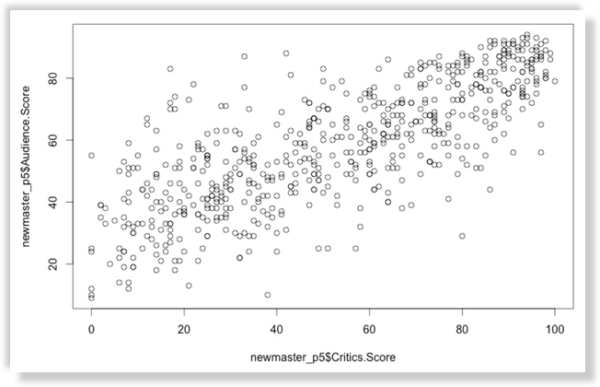
predictors like these means the Hollywood elite can no longer bribe, coddle, or otherwise staff a few privileged “experts” to say good things about their films.
because consumers are becoming increasingly lucid at spotting good art from bad, they are more likely to trust each others’ opinions than a critic’s, whose motivations are ambiguous at best.
(a parallel scenario already happened in the food business… Zagat was the leader, then Yelp launched a successful IPO without a single critic on staff.)
what this means for MoviePass
since MoviePass is the only player sharing the consumers’ interest — identify and experience great content — they can soon curate their own reviews, in-app.
in fact, MoviePass already does this, albeit with very little emphasis:

if MoviePass improves this effort through gamification, user profiles, voting… Rotten Tomatoes will be Zagat; MoviePass will be Yelp.
imagine a walled garden, protected not by paid gatekeepers, but movie fans (experts) with no incentive to lie about a film’s entertainment value.
would that affect IMDB, Rotten Tomatoes and Fandango influence over our film consumption?
you betcha.
inevitable future of MoviePass
my favorite aspect of this new reality?
we’ve seen it before:
- Yelp democratized food
- Pandora, Spotify, blogs democratized music (previously dictated by DJ’s)
- DIY solutions like VHS led to the 1980’s entertainment dry spell
consumers trust each other, and they [obviously] enjoy leveraging platforms and communities to extend and receive that trust.
because the mainstream system was wrought by elites of yesteryear – when films were cheap, in lesser supply, and theaters offered benefits not available at home… the jig worked for awhile.
but now, the jig is up.
parting advice
last month i rejoined MoviePass.
tapping ‘check in’ outside the box office to activate the debit card is as exciting as ever, and when i saw a movie last night, the couple in front of me used their MoviePass cards too.
i encourage you to consider MoviePass as your go-to theater fix — together, we can take back entertainment from pigs like Harvey Weinstein.
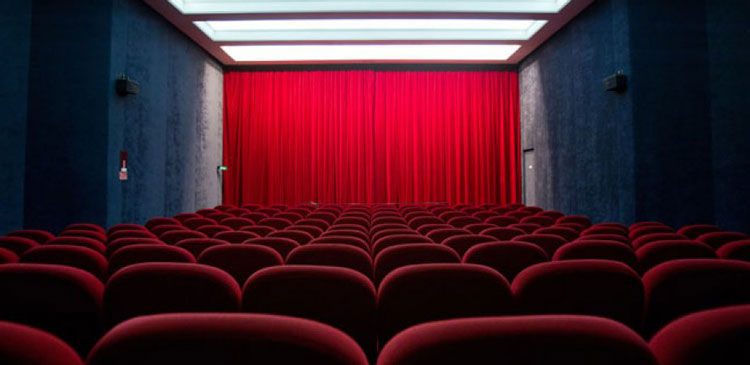
I have also been a subscriber to MoviePass since 2013 and was thrilled when the price changes to $9.95!
I had waited months and years for an IPP and was thrilled when Helios (Nasdaq HMNY) took over a majority stake and scheduled the IPO for 1st Qtr 3018!
I bought in August and seen the price run up quite significantly over $20, pulled out my original investment and maintain a block long term for the IPO!
I am convinced they will take over the industry and excited to see them incorporate tech from TrendIt (another company they purchased) as well as mapping from RedZone Map (an App they purchased)!
I watch Wisdom of the Crowd and only think what the homerun in MoviePass could signal for RedZone App as significant Facebook early tech employee (Mr Kelly) could pour a wealth of connections and knowledge into integrating Red Zone Map with Facebook!
Back to MoviePass: 20-30% cuts of tickets and concessions is the norm on a small scale now so I can easily see what is stated here if 30-50% deals in works.
The studios will have a major breakthrough ( ie LoganLucky marketing outside of Hollywood l and the success they had in 2017). Studios will use data from MoviePass and market movies direct to consumer to increase Movie to theater showings 200%! Lower budget productions will gain entrance and traction by direct consumer marketing to those who see their genre,
One word:Genius!
MoviePass is the Future
Let’s just hope MoviePass has good taste then.
+1
Nice write-up.
You had to do HW insult to encapsulate your thesis? Oh brother.
One point too, if everyone has moviepass and many more go to the theater, and in particular to specific movies, and those promoted by mp, mp limitation may in fact become lack of theater space.
whoops
sort of. i mentioned it may not be MoviePass per se, but rather the concept of theaters gaining more leverage in the film industry. AMC’s clone of MoviePass seems to be doing quite well.
HBO now has a post mortem documentary on this. Even at the time MoviePass seemed bound to fail to me. Adverse selection problem was absurd– like an insurance company that only insures burning buildings. A business like that lives on breakage which was never going to happen based on the heavy user self-selection.
Four years out from its collapse, and obviously Covid wasn’t in the cards at the time, the writing was really on the wall regardless. Consider: the rise of loss-leader acrylic HDTVs has changed the game. Used to be only rich people could afford a theater experience at home. Now, a 65″ screen costs like $300. In comparison the first HDTVs 20 years earlier were half that size and TEN TIMES that price! TVs are now one of the products which has decreased the MOST in price in the face of record inflation. Now rich and poor alike can afford a theater-like experience. Consider: Netflix was founded in 1997- LONG before ubiquitous high speed internet when all they were doing was mailing out DVDs. Why didn’t they call it “MailFlix”? B/c they knew– it was ALL going online, bruh– not just the selection process but the viewing too.
Now add to that the rise of cheap, fast WiFi and the producers are happy they can bypass the theaters. Premium video on demand (PVOD) is now a huge revenue center for Hollywood. $20-25, less than the cost of 2 tickets, you can rent or even own the movie weeks after the theatrical release, if not simultaneous to it. And you don’t have to deal with schlepping to the theater, finding a time that works, sticky seats with a century of beer farts, and most importantly assholes next to you who can’t shut up or stay off their phone! (Anecdotally, I haven’t gone to a theater since maybe a year or more before Covid and don’t miss it at all. Clearly I’m not alone)
Theaters will always exist just like Broadway exists but it will exist for a smaller segment of moviegoers and movie options. Only the biggest blockbusters with the biggest multiples (and Taylor Swift concert films I guess) will be worth it for consumer and theater owner alike. The theaters have always been cartels, gangsters who held movies hostage for months from the at home audience. And nature abhors that and always, ALWAYS does what it can to disintermediate those interlopers wherever possible, as it has here.